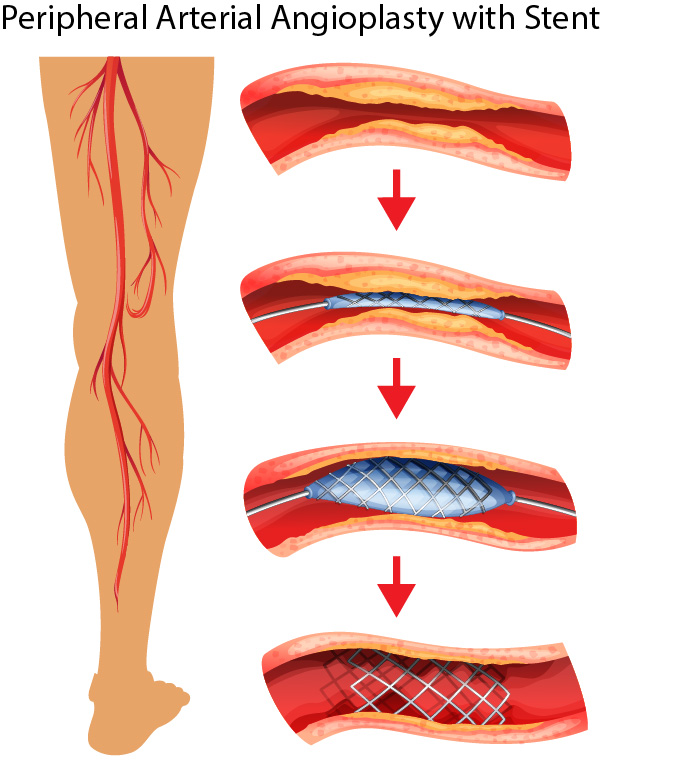Also known as: balloon angioplasty, transfemoral angioplasty, radial angioplasty
Duration: 30 minutes (but can take longer depending on complexities)
Peripheral angioplasty is a minimally invasive procedure used to open up blocked or narrowed peripheral arteries (blood vessels of the legs and arms). It follows the peripheral angiogram and restores blood flow to the lower limbs without the need for vascular surgery. This procedure is usually followed by placing a stent (a short wire-mesh tube) into the affected artery.

Access Sites:
- Transfemoral – when angioplasty is performed through your femoral artery (groin area)
- Radial – when angioplasty is performed through your radial artery (wrist area)
- Popliteal – when the angioplasty is performed through your popliteal artery (behind the knee)
- Pedal – when the angioplasty is performed through your pedal artery (foot)
Uses:
- In peripheral arterial disease (PAD) to open up narrowed or blocked peripheral arteries which can cause leg pain and ulcers
Preparing for the procedure:
![]() Download Pre Procedure Instructions
Download Pre Procedure Instructions
How it is performed:
- Firstly, a peripheral angiogram is performed to check for any blocks in the arteries of the legs. A catheter (a thin, long tube) is placed in either your arms, legs, or groin and is monitored by an x-ray camera until it reaches the targeted artery (arteries).
- A contrast dye is then infused so that the arteries can be seen.
- If an artery is blocked, you may require a balloon angioplasty to open it up.
- In balloon angioplasty, the tip of the catheter will be fitted into the blocked artery and the balloon is inflated. This pushes the plaque against the wall of the artery, creating more space for blood to flow easily.
- Once blood flow is established, the catheter is deflated and removed.
Stent Placement
- Most patients who undergo balloon angioplasty may also have a stent (a small, collapsed tube made of wire mesh) placed inside the treated artery.
- The balloon of the stent is inflated, causing it to expand against the wall of the artery.
- Once placed, the balloon is deflated and withdrawn.
Stent Types:
- Drug-Eluting Stents (DES) – is coated with medication to keep the arteries from clogging again and to prevent scar formation. Most stents are of this type.
- Bare Metal Stents (BMS) – is not coated with medication
After the procedure:
![]() Download Post Procedure Instructions
Download Post Procedure Instructions
Show references
Robertson L, Paraskevas KI, Stewart M. Angioplasty and stenting for peripheral arterial disease of the lower limbs: an overview of Cochrane Reviews. Cochrane Database Syst Rev. 2017;2017(2):CD012542. Published 2017 Feb 1. doi:10.1002/14651858.CD012542
Medical Advisory Secretariat. Stenting for peripheral artery disease of the lower extremities: an evidence-based analysis. Ont Health Technol Assess Ser. 2010;10(18):1-88.
Axisa B, Fishwick G, Bolia A, et al. Complications following peripheral angioplasty. Ann R Coll Surg Engl. 2002;84(1):39-42.
Henry M, Klonaris C, Amor M, Henry I, Tzvetanov K. State of the art: which stent for which lesion in peripheral interventions?. Tex Heart Inst J. 2000;27(2):119-126.
Topfer LA, Spry C. New Technologies for the Treatment of Peripheral Artery Disease. 2018 Apr 1. In: CADTH Issues in Emerging Health Technologies. Ottawa (ON): Canadian Agency for Drugs and Technologies in Health; 2016-. 172. Available from: https://www.ncbi.nlm.nih.gov/books/NBK519606/
